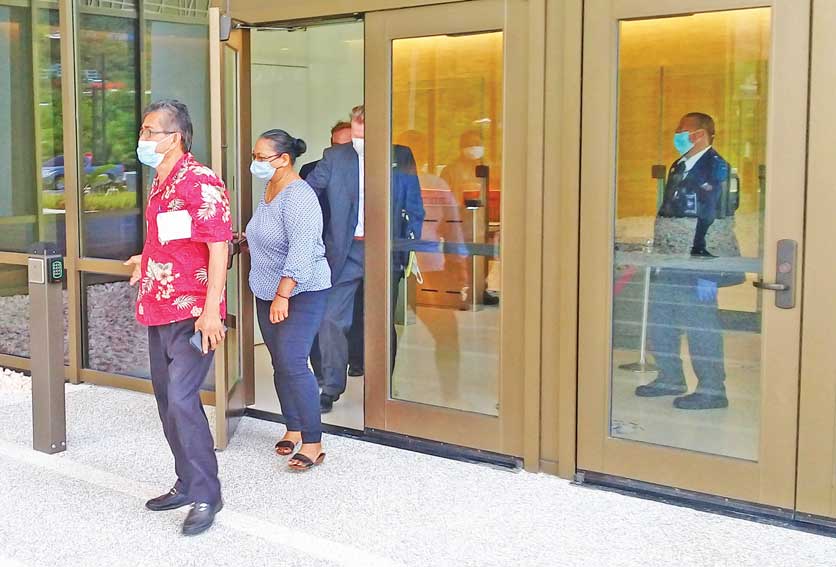Jury selection starts in Atalig trial
8 Guam-based witnesses OK’d to testify by video

Rota Mayor Efraim M. Atalig and his girlfriend, Evelyn Atalig, exit the main entrance of the U.S. Courthouse in Gualo Rai during a lunch break yesterday. The jury selection in the trial of the Ataligs started yesterday. (FERDIE DE LA TORRE)
The prosecution and the defense in the case against Rota Mayor Efraim M. Atalig and his girlfriend, Evelyn Atalig, agreed yesterday that eight witnesses who are residing in Guam may testify via video-teleconference from the federal courthouse in Guam because of the COVID-19 situation.
This developed as U.S. District Court for the NMI Chief Judge Ramona V. Manglona started the jury selection process yesterday. The trial will resume today, Wednesday, at 8:15am.
Assistant U.S. attorney Eric S. O’Malley, counsel for the U.S. government; David G. Banes, counsel for Efraim Atalig; and Steven P. Pixley, counsel for Evelyn Atalig, have all agreed to allow the eight Guam witnesses to testify via video-teleconference.
The witnesses are Chelsea Ann F. Aquai, Julie Rivera, Angel R. Sablan, Kevin Susuico, Carmen I. Aguigui, Frank Salas, William Mendiola Castro, and Edward San Nicolas.
With their testimonies delivered through video at the federal courthouse in Guam, this “ensures that the testimony will be both reliable and subject to an adversarial testing in a manner functionally equivalent to that accorded live, in-person testimony,” said O’Malley, Banes, and Pixley.
Current quarantine measures generally require all incoming persons to be quarantined for a certain period of time after entering the CNMI. This means that, if off-island witnesses are required to testify in person, they would have to fly to Saipan days before the date they are expected to testify to undergo the quarantine procedure.
Furthermore, the lawyers said, being aboard a flight is a potential risk factor for contracting COVID-19, and if those witnesses contract COVID-19 during their flights, the quarantine period may be even longer.
Meanwhile, the prosecution filed Monday and yesterday a motion to quash defendants’ subpoenas that sought the personnel records of OAG’s Travis Hurst, and OPA’s Edward R. Cabrera, and Juan Santos, who are criminal investigators who participated in the investigation of this case and may testify as witnesses for the U.S. government. The return date for both subpoenas was yesterday, Aug. 11, at 4:30pm.
In the U.S. government’s first motion to quash, O’Malley said the U.S. government has an interest in preventing the defendants from harassing its witnesses. He said the OAG and OPA have already produced all relevant evidence requested by the defendants’ subpoena to the U.S. government and any responsive material has been provided during the ordinary course of discovery.
Forcing OPA and OAG to comply with this overly-broad subpoena will serve no legitimate purpose, he added.
Yesterday, assistant U.S. attorney Garth R. Backe, who is co-counsel of O’Malley, also moved the court to quash the subpoena for Hurst’s tax records.
Backe said the subpoena was issued Monday, Aug. 10, and addressed to the CNMI Department of Finance, Division of Revenue and Taxation and seeks “all tax records of Hurst filed for the period of 2011 to 2014.” The requested return date is today, Wednesday, Aug. 12, at 9am.
Backe said compliance with the subpoena would be unreasonable and oppressive, because, in addition to being an unwarranted invasion of privacy, disclosure of Hurst’s tax returns and return information would constitute a direct violation of CNMI law.
Last Friday, Manglona granted Efraim Atalig’s renewed motion for remote testimony of his eight witnesses at trial.
The charges against Efraim and Evelyn Atalig involve at least eight trips taken by the couple at different times in 2018 to Guam, Palau, the U.S. mainland, South Korea, and Saipan.
The Ataligs are being charged with conspiracy to commit wire fraud and theft from program receiving federal funds, wire fraud, and theft from program receiving federal funds. Both are also charged separately with false statement.























